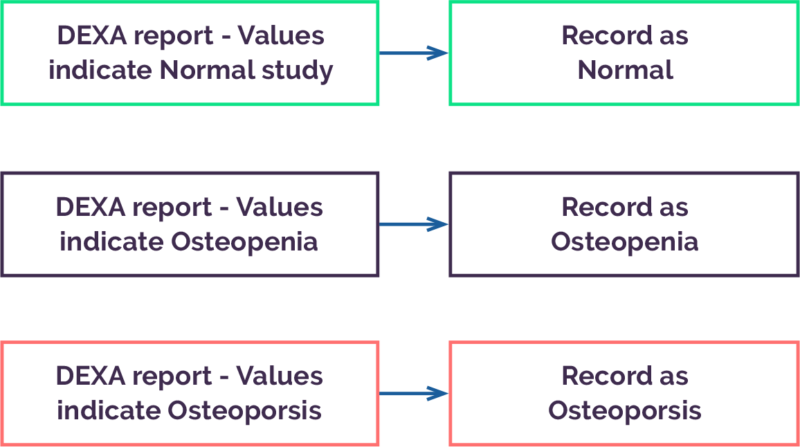Review
Case finding
‘Case finding’ is a review of electronic case records to identify patients with osteoporosis but do not have that mentioned on their records. Three different approaches are suggested below. These searches can be set up by practice administrative teams. Clinical oversight will be needed when assessing fragility fractures and DEXA outcomes from clinical notes.
Approach 1 – Identify potential fragility fractures from A&E, secondary care or other referral sources
Suggested search time frame
From 1/4/2012 (to coincide with QOF requirements)**.

Codes that need to be drawn up for case finding searches
- Fracture of bones of trunk
Fracture of vertebral column
Fracture of pelvis
Fracture of upper limb
Fracture of lower limb - Fragility fracture (50-74) and fragility fracture 75 and over
- Codes for common fragility fractures (hips, vertebrae, distal radius, proximal humerus)
Fragility fracture
Fragility fractures are fractures that result from mechanical forces that would not ordinarily result in fracture, known as low-level (or ‘low energy’) trauma such as falling from a standing height or less.
Types of fragility fractures: Vertebral fractures, fractures of the neck of the femur, upper humerus, distal radius, tibial plafond.
Exclude: Fractures of the skull, fingers, toes, scaphoid. Fractures from falls over 6 feet or from RTAs.
Approach 2 – Identifying patients who are on Bone Sparing Agents – (BSA) but have no osteoporosis codes
Suggested search time frame
From 1/4/2012 (to coincide with QOF requirements)**
Cohort 1: Patients on current Bone Sparing Agents but not the osteoporosis register
Cohort 2: Patients on past Bone Sparing Agents but not the osteoporosis register
Search on codes for the following Bone Sparing Agents
- Alendronic Acid
- Risedronate Sodium
- Disodium Etidronate
- Strontium Ranelate
- Raloxifene Hydrochloride
- Zoledronic Acid
- Denosumab
- Teriparatide
- Ibandronic Acid
Approach 3 – Identifying patients who have had DEXA scans and have no diagnosis code
Suggested search time frame
From 1/4/2012 (to coincide with QOF requirements)**

Please refer to the DEXA scan result subset codes in the most current QOF business rules to guide your searches.
Please follow up as per current guidelines:
- https://cks.nice.org.uk/topics/osteoporosis-prevention-of-fragility-fractures/management/management/#follow-up
- https://www.sheffield.ac.uk/NOGG/NOGG%20Guideline%202017.pdf (section 7)
**2019/20 General Medical Services(GMS) contract Quality and OutcomesFramework (QOF) – Page 77


